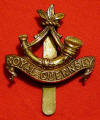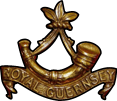
the unofficial pages
Thank you to Ernest Owen and Stephen Foote for getting us started.
In 1750 the infantry militia of the island were formed into three regiments. The regiments of foot had Grenadier companies and pioneer and later green coated rifle companies made their appearance.
Although the regiments of Foot who wore civilian clothing had existed as early as the 17th century, in 1780 they were ordered to provide themselves with red coats and white stockings.
In an order of January 1814 to the Captains of the North, South and West Regiments these were designated as light infantry.
In a manuscript at the Record Office, variously dated 1800 to 1815, gives the following details:
East Guernsey red faced buff, white lace with red central stripe, North Guernsey red faced green, white lace with green central stripe. South Guernsey red faced blue, white lace with a red central stripe. West Guernsey red faced black yellow worsted lace.
Further details dated 1820 may well have applied to the earlier period with the exception of the head-dress which had changed.
Infantry:
East Guernsey, red faced buff, officer gold lace, drum major and drummers buff faced red, privates lace as above.
North Guernsey, red, light green facings, drummers green faced red, lace as above, officers gold lace.
South Guernsey, red faced blue, lace as before.
West Guernsey, red faced, light yellow, drum major and drummers, yellow faced scarlet, band master white faced red, lace white with a red stripe, officers' lace gold except on shako which was silver. (Lawson, Cecil C. P.; "A History of Uniforms of the British Army, Volume V";Kay & ward, Ltd., London; 1967. Pp 64-65.)
The Royal Guernsey Militia.
1st or West Battalion. (Light Infantry)
2nd or East Battalion. (Light Infantry)
(Barnes, R. Money; "The British Army of 1914"; Seely Service & Col, Ltd., London; 1968. Pp 286).
Royal Guernsey Light Infantry (1860)
The RGLI was formed 17th December 1916 so that Guernsey would have a fighting unit bearing its name rather than let islanders fight under the names of the Irish regiments they had been joining up to that point. Before that the island's military unit was called the Royal Guernsey Militia. Guernsey is a Crown Dependency and not part of the UK - so the allegiance to the King (and not the UK government) is the reason why Guernseymen were drawn into fighting in the British Army in WW1. There were 4 Battalions from 1914-1921. The 1st was in France and Flanders from 27 September 1917. On 27 April 1917, after heavy casualties in the Battles of the Lys, it went to G.H.Q. Troops. Naming on medals 'R. Guernsey L.I.'.
Disbanded in 1947. The badge was in gilding metal. Personnel from the Royal Guernsey Light Infantry Battalion joined the 6th Service Battalion, The Royal Irish Rifles in 1915 and in 1916 a Reserve Battalion was raised for duty in Guernsey. (Cox, Reginald H. W.; "Military Badges of the British Empire 1914-18"; Ernest Benn, Ltd. London; 1982.)
Check out Museum of the Royal Guernsey Militia, Castle Cornet, St. Peter Port, Guernsey. Their display includes items of the Royal Guernsey Light Infantry from the 18th Century until it's disbandment in 1940.
There is a book on the regiment as follows:

PARKS, Major Edwin, Dieux Aix: God Help Us - The Guernseymen Who Marched Away 1914-1918, States of Guernsey, 1992, 172 p., 8 maps, 19 illustrations. 7 appendices containing names. Also details 9th Divisional Ammunition Column, The Quarry Companies Royal Engineers, 245 (Guernsey) Army Troops Company Royal Engineers and Guernseymen in the 6 Royal Irish Regiment and 7 Royal Irish Fusiliers.
An invaluable book for anyone whose Guernsey ancestors fought in World War I. It contains the story that Royal Guernsey Light Infantry played in the war, illustrated with maps and photos. More than half the book is devoted to appendices which list all the individuals who took part including details of medals and injuries.

